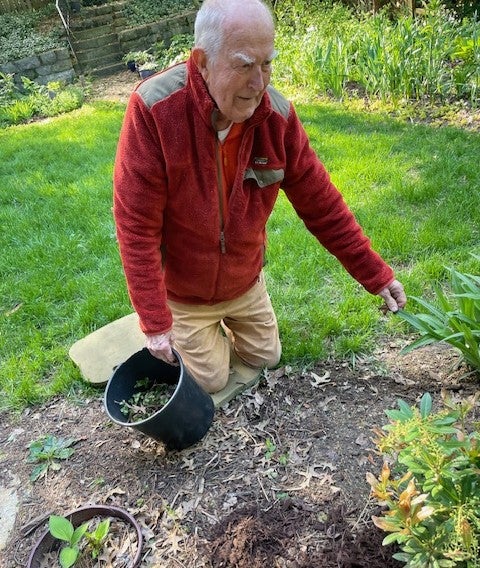The Scoop: Spring Gardening
Published 5:15 pm Friday, May 3, 2024

- Gardening becomes more challenging as we age. Garden Club member Charles Meshako, 88, has adapted his garden work over the years but he certainly hasn’t given up. Here he uses foam pads to protect his knees while mulching a recently planted shrub. He is careful to support himself while rising. Charles and his wife Diane say gardening helps them stay fit and active. Photo submitted
By Susan Jonas
Garden Club of Danville
Oh, my aching back! Welcome to spring in Kentucky with all its opportunities for sore muscles, blisters, and sunburned noses. But keep your eyes on the prize. This is one of the most strenuous but rewarding periods in the garden. The coming weeks will determine your garden’s performance in the year ahead. Do it right and the rest of the year will be much easier.
Wise gardeners make weed pulling the first task after a long, soaking rain has softened the earth. Weeds give up their grip easily, entire root systems intact, leaving nothing to re-sprout. Get ahead of them now, and your summer will be much easier. Once the soil dries out and weeds get established, they are much harder to pull and you’re more likely to leave parts of them behind, which perversely often makes them spread even further.
Weeding becomes increasingly difficult as we age. Old gardeners like me must devise methods for getting down to the ground and, more importantly, back up again. Hand pulling small weeds is easy, but my back won’t tolerate much stooping anymore. However, if I don’t pull all the tree seedlings sprouting in my garden, it will be a mini forest by fall. My favorite tools for weeding are a couple of helpful teenagers, much more energetic and flexible than I am.
If you suspect there are more tree seeds than usual this year, Alexis Sheffield at the Boyle County Extension Service says you are correct. This is what is called a mast year, when seeds and nuts are extra prolific.
“With the good levels of moisture last year, we are seeing a bumper crop of seeds coming off trees. This is just a part of the natural cycle of the trees along with last year’s good weather for production,” she said.
Once all the weeds are pulled and new plants tucked in, you may choose to mulch the bare ground, which smothers most later weeds. Many organic mulches are free, even if they aren’t always the most attractive. Chopped leaves, dry, untreated grass clippings, straw, and homemade compost all work well.
These mulches improve soil fertility, feed the plants, and make your landscape look tidier. The Garden Club of Kentucky urges gardeners to shun the dyed mulches that are unattractive and can harm your plants. Dyed mulches are often made from old ground-up pallets that may contain wood treated with chemicals such as arsenic. The artificial dyes leach into the soil and can stain nearby structures.
Hot summers are hard enough on garden plants without surrounding them with black mulch that absorbs even more heat. The red dyed mulch is glaringly artificial and unnatural looking. If you’re buying shredded bark mulch, please choose the natural variety, and the coarser it is, the better. Finely shredded bark mulch might look pretty when it is first spread, but it soon packs down, forming a crust that sheds water. Coarse chips allow water to penetrate.
Now, here’s a gentle reminder for all you enthusiastic gardeners who just can’t wait another day to plant tomatoes and other tender annuals. The last frost date for central Kentucky is somewhere between May 1 and May 10. A good planting guide is to wait until night temperatures have been above 50 degrees for a week. The tomatoes you put out now will not grow as fast or do as well as those planted later.
All these tasks in the spring garden tempt us to focus on chores. Please don’t neglect the pure pleasure of looking, smelling, and listening for spring in your garden. Early wildflowers and bulbs won’t be here long. All the colorful blooming trees and shrubs will be plain green in a flash. Don’t miss them because you’re too busy working.
Canadian author Margaret Atwood said, “In the spring, at the end of the day, you should smell like dirt.” Fresh, damp earth is the smell of life, with the promise of good things to come. Get out there and enjoy it.






